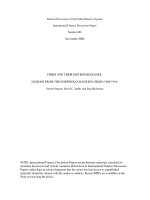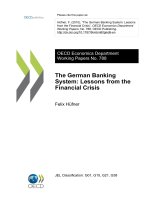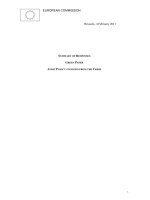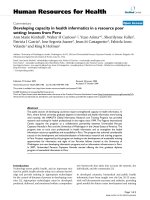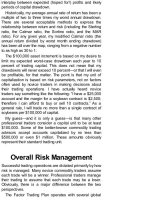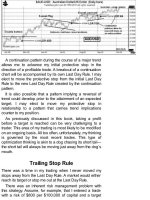Diary of a Professional Commodity Trader: Lessons from 21 Weeks of Real Trading_13 pptx
Bạn đang xem bản rút gọn của tài liệu. Xem và tải ngay bản đầy đủ của tài liệu tại đây (1.24 MB, 24 trang )
best advice I have ever been given. This highly successful chart
trader said, “Trade to the far right of the chart page.”
In other words, the best decisions in chart trading are those
that are delayed …delayed …delayed …delayed! Do not
anticipate what a chart might become. Make a chart prove itself.
Do not lead a breakout. Do not determine what a chart will do;
instead, make the chart do it.
Whether a trade will be a profit or loss should not be a
chartist’s concern. Rather, waiting for a chart’s “appointed
time” should be the focus of a chart trader.
Sage advice, indeed!
I’ve created a list of best practices based on my recent
trading performance, but I suspect it would apply to many
other chart traders out there, whether they’re just starting
out, struggling with bad performance, or just looking for
ways to improve an already successful trading operation.
Practices that I—and other chartists—could focus on in
the future are:
Look at the weekly chart of a specific market no
more than once each week. Look at the daily
chart of each market no more than once each
day. Do not pay any attention to intraday charts
unless it is to set money management protective
stops on entry orders that were executed.
Predetermine orders prior to the late afternoon
opening. Use good-til-canceled (GTC) open
orders wherever feasible. Avoid resting orders in
thinly traded overnight electronic trading
sessions, such as the grains, meats, or fibers.
Do not modify the protective stop level on trades
based on major breakout signals more than
once each week.
D o not chase a missed signal. There will be
trading opportunities next week, next month, and
next year. Chasing signals can lead to other
serious breaches of trading practices.
Have limited exposure to intraday market
volatility.
Be more aggressive in taking profits on trades
other than major breakout signals.
Enter profit-taking orders in advance. Once a
profit is taken in a market, avoid that market for
several days.
Never take a losing trade home over a weekend.
If a trade is a loser on a Friday, get out.
Do not become too attached to trading a given
market or obsess over missed opportunities.
There is always another day and another chart
pattern in a different market.
Do not pay attention to what other
traders/analysts are saying or doing. Work your
own program.
Trade to the right-hand side of the chart (see the
sidebar earlier in this chapter).
Maintain and review a one-year daily
continuation chart for all markets traded. Any
pattern considered for trading should be among
the five best examples of classical charting
principles during the past year.
Avoid all patterns of less than six to eight weeks
in duration.
I eagerly look forward to many years of trading based on
the experiences and lessons I gained preparing and writing
this book. While this book required far greater time and
devotion than I would have ever anticipated, I believe I will
be a better trader in the future as a result.
I hope that you—the reader—gained even a small
proportion of education from reading this book that I gained
from writing it.
Chapter 14
The Best Dressed List
This chapter presents the Best Dressed List for the period
January 2009 through April 2010. The Best Dressed List
represents the best examples of classical charting
principles. The criteria for inclusion on the Factor Best
Dressed List include the following:
“No question about it” classical chart pattern on
the weekly chart of at least 10 to 14 weeks in
duration.
Corresponding and supporting chart structure on
the daily charts for the same market.
A decisive breakout of the pattern boundary or
ice line with little or no pattern reentry.
A sustained trend to the price target implied by
the classical chart configurations.
Whether the Factor Trading Plan participated in whole or
in part of the trends represented by the Best Dressed List
is not a conscious criterion. However, the Factor Trading
Plan and its long-term profitability are predicated on a
certain level of actual participation in the trends
represented by the Best Dressed markets.
Markets included in the Best Dressed List for the period
January 2009 through April 2010 are shown in Table 14.1.
TABLE 14.1 Best Dressed List, January 2009–April 2010
A Seven-Month Double Bottom
in AUD/USD
The advance in late April completed a double bottom on
the weekly and daily charts (Figures 14.1 and 14.2). The
daily chart is best described as a compound fulcrum, a
phrase borrowed from point and figure charting. In classical
charting principles, a compound fulcrum bottom resembles
a complex H&S top pattern that breaks out to the upside.
The market had a premature breakout in mid-April, but was
finally resolved by the advance on April 30 and the close on
May 1. The target of 8289 was met on July 28. The
consolidation in June and early July was tricky, but was
resolved with a fishhook pyramid buy signal on July 14.
FIGURE 14.1 Double Bottom on the Weekly AUD/USD
Graph.
FIGURE 14.2 Double Bottom on the Daily AUD/USD
Graph.
A 14-Month Coil and NineMonth Descending Triangle in
EUR/CHF
In December 2009 the EUR/CHF chart simultaneously
completed two classical chart developments—a 14-month
six-point triangulation or coil (labeled A–F) and a ninemonth descending triangle. The initial target was reached
in late March. Figure 14.3 shows the weekly graph, and
Figure 14.4 is the daily chart. I completely missed this
trade, seeing the chart after the move had begun.
FIGURE 14.3 Descending Triangle and Symmetrical
Triangle on the Weekly EUR/CHF Chart.
FIGURE 14.4 The Breakout and Run to the Target on the
Daily EUR/CHF Chart.
A Six-Month Wedge in
EUR/USD
The decline in early December simultaneously violated a
nine-month trend line and completed a six-month wedge on
the weekly chart (Figure 14.5) and completed a five-week
channel on the daily graph (Figure 14.6). The target was
met on February 4, 2010. The March through December
advance was tricky, and several false and premature
breakouts occurred before this decline came to fruition. For
full disclosure, I personally took profits way too early in this
trend, using the target of the five-week channel rather than
the six-month wedge.
FIGURE 14.5 Weekly EUR/USD Graph Displays Major
Trend Line and Rising Wedge.
FIGURE 14.6 The Breakout and Run to the Initial Target on
the Daily EUR/USD Graph.
A 16-Week Horn in GBP/USD
Following the prolonged decline in the GBP/USD in 2008,
the market formed a rare 16-week horn bottom that was
completed on May 8. See the weekly chart in Figure 14.7.
FIGURE 14.7 A 16-Week Horn on the Weekly GBP/USD
Graph.
The daily chart (Figure 14.8) shows that the breakout
hovered at the ice line of the pattern for several days
without challenging the Last Day Rule before trending
steadily to the target, reached on June 3.
FIGURE 14.8 The Breakout and Run to the Target on the
Daily GBP/USD Graph.
A Four-Month H&S in Bottom
NZD/USD
The advance on May 19 in this forex pair completed a fourmonth-plus H&S bottom on the weekly graph, as shown in
Figure 14.9. Notice that the right shoulder was quite
abbreviated relative to the left shoulder. While symmetry is
desirable, abbreviated right shoulders are generally much
more trustworthy than are extended right shoulders.
FIGURE 14.9 H&S Bottom and Continuation Triangle on
the Weekly Chart of NZD/USD.
Notice on the daily chart (Figure 14.10) that the first
breakout attempt on May 8 and 11 pulled back briefly
below the neckline. However, the close on May 19
confirmed the deal, and the target was reached on
September 7.
FIGURE 14.10 Daily Chart of the H&S Bottom in
NZD/USD Displays a Stutter at the Breakout.
After the initial thrust in late May, the market paused to
form a six-week continuation triangle. This offered an
opportunity to pyramid the initial position.
A Six-Month Ascending
Triangle Failure in USD/CAD
This market situation was shown earlier in the book in
Chapter 4. In April, the forex pair completed an ascending
triangle failure on the weekly graph, as shown again in
Figure 14.11.
FIGURE 14.11 Downside Breakout of Ascending Triangle
on the Weekly USD/CAD Chart.
I term this as a failure pattern because the natural bias of
a right-angled triangle is to break out through the horizontal
boundary. The daily chart, as shown in Figure 14.12,
experienced a premature breakout on April 14, followed by
a move back into the pattern. On April 24, the market
experienced the second and final pattern completion. The
target was reached on May 29.
FIGURE 14.12 Daily USD/CAD Graph Shows Initial
Breakout Failure Followed by Pattern Recompletion.
An Eight-Month H&S Bottom in
the S&Ps
There is always at least one chart each year that I refuse to
believe. I usually lose money attempting to fade the trend
produced by these patterns. In 2009 (and 2010 to date), it
has been the Standard & Poor’s (S&Ps). In real time, I saw
the eight-month weekly chart H&S bottom in the Mini S&Ps,
as shown in the weekly chart in Figure 14.13.
FIGURE 14.13 H&S Bottom on the Weekly Graph
Reverses the 2008 Meltdown in the S&Ps.
The Last Day Rule of the July 23 breakout was never
remotely challenged (see Figure 14.14). The target of this
pattern has not yet been met, and it is anyone’s guess if it
will be met.
FIGURE 14.14 Daily S&P Chart Shows Clean Breakout of
H&S Bottom.
A 14-Month Symmetrical
Triangle in Sugar
The dominant pattern in this market was the 14-month
symmetrical triangle on the weekly graph, completed on
May 1, 2009 (see Figure 14.15).
FIGURE 14.15 2007–2009 Bull Market on the Weekly
Sugar Chart: A Study in Classical Chart Patterns.
The pattern objective was met on August 6. There were
several smaller pyramid opportunities during this trend (not
shown). The counterpart pattern on the daily graph was a
running channel or wedge, as shown in the weekly chart
version of the May 2010 contract in Figure 14.16.
FIGURE 14.16 Running Wedge and Symmetrical Triangle
Propel 2009 Bull Run in May Sugar.
Both the weekly and daily charts developed a welldefined continuation pattern, completed in mid-December
2009. The target was quickly met on January 6.
A Seven-Month Triangle in
Gold
The gold market for most of the year epitomized the
concept of pattern redefinition, as daily chart patterns
formed, failed, and then became part of larger chart
construction. This happened from February through early
September. Figure 14.17 shows this period of congestion
on the weekly graph. I detailed the constant redefinition of
the daily gold charts in 2009 as a case study in Chapter 6.
FIGURE 14.17 Seven-Month Symmetrical Triangle on the
Weekly Gold Chart.
This congestion took the form of a seven-month
symmetrical triangle. On September 2, the market
completed the symmetrical triangle with a daily advance of
$22 per ounce (see Figure 14.18). After seven months of
being burned by buying strength and selling weakness, it
was difficult to go long on top of a one-day rally of $22. Y
et
purchases made at the close of the breakout day were
never put into harm’s way.
FIGURE 14.18 Symmetrical Triangle Breakout on the Daily
Gold Chart.
The markets have a way of breaking down a trader’s
patience during the course of a prolonged congestion to
the point that it is easy to doubt the real move when it
comes. There are numerous examples over the years of
markets that picked my pocket with premature breakouts,
and I never became fully committed to the real breakout
when it came.
FIGURE 14.19 Multiple Continuation Patterns on the Daily
Copper Graph.
The Goal of the Markets Is to
Separate You from Your Money!
A trader much wiser and more profitable than I once said that
the real purpose of capital and speculative markets is to
transfer wealth from the many to the few, and that the
speculative markets would cease to exist if over the long term
they failed to deliver on this purpose. The practical implication
of this, if true, is that the goal of the markets is to separate me
from my money. Of course, the markets are not setting out in
some coordinated and conscious way to do this. The markets
do not represent a single cogent entity. Yet I believe that
markets behave in an organic manner that can accomplish the
same end.
A Series of Continuation
Patterns in Copper
Figure 14.19 is presented once again as a wonderful
example of how a major trend can occur through a series of
small continuation patterns on the daily chart. In the case of
copper, five individual patterns averaging seven weeks in
length all formed above the dominant 10-month trend line.
To be perfectly honest, I believe that a sequence of patterns
such as displayed on this chart is much more easily seen
after the fact. While I admire the beauty of this trend after
the fact, the trend itself was a very difficult one for me to
trade.
An H&S Bottom in Crude Oil
As a general rule, the best weekly charts to use are those
that track the nearby contract month (also referred to as the
active month) either through the first delivery notice date or
through the expiration of the contract. I monitor both weekly
charts.
I also look at the life-of-contract weekly chart of the most
actively traded contract month. This can sometimes provide
valuable information. Finally, there are times when the
weekly chart of a specific deferred contract will show the
clearest pattern. This was the case in crude oil in 2009.
Figure 14.20 is the weekly chart of the October 2009
contract. The advance in early May completed a 23-week
H&S bottom pattern.
FIGURE 14.20 H&S Bottom on the Weekly Chart of
October 2009 Crude Oil.
The daily chart of the October contract, as shown in
Figure 14.21, displays the closing price line. Often, a
closing price chart can provide
FIGURE 14.21 Daily Close-Only Chart Defines H&S
Bottom in October 2009 Crude Oil.
insight into the timing of a breakout because it eliminates
the intraday noise. The market completed its H&S bottom
on May 6, hesitated for a week, then trended directly to
reach the target on June 10. Remember, the closing price
is the most significant price of the day. Everything else is
noise. I all too often let the noise confuse me.
Summary
Some years have more qualified candidates for the Best
Dressed List than do other years. For example, the charts
in 2008 were loaded with great weekly chart patterns
offering strong breakouts and trends, especially in the
traditional raw material commodities. The Factor Trading
Plan depends on these types of classical charting
situations to produce profitability. Without catching some of
these chart situations, my trading tends to tread water.
There have been relatively few Best Dressed List market
situations in the five months covered by this book. In fact,
the only Best Dressed trading events since December that
have met their implied price targets have been the
EUR/USD, EUR/CHF, and the final thrust in the sugar bull
market. I did not fully exploit EUR/USD, caught sugar, and
completely missed EUR/CHF.
Some years are better years for the charts and for chart
traders, but there is one reality that all chartists must
embrace. There have been wonderful chart situations in the
past and there will be wonderful chart situations in the
future. The most important asset that a trader has is his or
her trading equity. It is vital that trading equity be protected
during those times when the charts are not providing
excellent opportunities, or when a trader just can’t get in
step with the rhythm of the markets.
Remember, it is easy to make money in the commodity
and forex markets when the charts are working and trends
are sustained, but the challenge is to keep the profits
during the tough times.
Postscript
The last regular entry into the trading journal was made on
April 20, 2010. It is now very early June 2010, my last
chance to add content to the book, and I’d like to take this
opportunity bring you up to date on the Factor Trading Plan.
Final Performance
May was my best month by far in 2010. I closed out the
Diary of a Professional Commodity Trader on April 20
with a cumulative gain of 5.4 percent. Y will recall that my
ou
optimistic goal for the period covered by the book was a
gain of 10 to 15 percent.
From April 20, the end of the diary, through May 31, the
Factor Trading Plan experienced some excellent trades,
and the six-month gain from December 7, 2009 (the first
trade of the diary), through the end of May stands at 9.6
percent. This is the actual gain by the fund traded by Factor
LLC. Of course, who knows what the future will bring.
Specifically, the profits in the past five weeks have come
from two markets.
The Stock Market Turns Down
As shown in Figure PS.1, the June Dow Jones Industrial
Average completed a small H&S top on May 4. I shorted
the completion of this top. The target of 10630 was quickly
met and far exceeded. The retest rally through May 13 took
the form of a rising wedge and offered the opportunity to
again trade the stock indexes from the short side.
FIGURE PS.1 A Small H&S Pattern Created a Top in
DJIA.
As of this writing, a multi-month H&S top looms large and
the bears appear to be in control.
The Trading Range in AUD/CAD is
Resolved
Y may recall from Chapter , Figures 11.5 and 11.6, the
ou
severe whiplashing I endured when the daily AUD/CAD
chart worked its way too far toward the apex of a triangle. I
went from short to long to short, each trade being a loss.
Figure PS.2 shows that the trading range in this forex
pair was finally resolved. The decline on May 11 confirmed
a 14-week rectangle and a possible six-month descending
triangle. This chart has already qualified for the 2010 Best
Dressed List. The downside target has been met.
FIGURE PS.2 Major Sell Signal in AUD/CAD.
Performance Compared to
Other Benchmarks
It has been a tough six months for commodity traders.
Table PS.1 compares the performance of the actual
commodity/forex pool traded by Factor LLC in accordance
with the diary in this book against some benchmarks
commonly used by the futures and forex industry. The
benchmarks are the Lyxor CTA Index, the Barclay Hedge
NewEdge CTA Index, and the S&P 500. Lyxor and Barclay
track the commodity trading advisors (CTAs) managing
large assets in the forward commodity and forex markets.
TABLE PS.1 Factor Trading Plan (Actual) versus Industry
Benchmark Comparisons, December 2009–May 2010
Note: Proxy for Factor Trading Plan is the Factor Classic Fund, all fees
included.
Sources: SPX closing price; Factor internal audit; www.BarclayHedge.com;
www.LyxorHedgeIndicies.com.
Past Month
Past Six Months (December
Asset
(May 2010)
2009–May 2010)
Factor Trading Plan
Factor Goal of 18%
annual rate of return
S&P 500
BarclayHedge NewEdge
CTA
+7.8%
+6.2%
+1.5%
+9.0%
(9.2%)
(0.5%)
(1.4%)
(1.3%)
Lyxor ST & LT CTA Index (0.2%)
(equal weight)
(2.38%)
No representation is made that this relative performance
would hold true for any period of time other than the time
covered by the diary of the book. The Factor Trading Plan
could underperform or outperform industry benchmarks
during any other floating periods of time.
Putting it in Perspective
Five or six months is a microcosm in the life of a trader.
Frankly, six months, or even a year, really do not matter very
much. I want to end this book by placing the past six months
into the perspective of my career as a trader.
Figure PS.3 shows the trading performance of the period
covered by this book into the context of my trading from
1981 through May 2010. This is a graph of the Value
Added Monthly Index (VAMI) representing the growth of
$1,000 without factoring in additions or withdrawals. Note
that the period of the book is marked on the graph.
FIGURE PS.3 Factor Trading LLC Performance, 1981
through April 2010.
This graph makes a pro-forma adjustment to reflect the
fact that I am currently trading with about one-third of the
leverage I used from 1981 through 2008. So, the VAMI is
constructed using monthly rates-of-return that are only onethird of the actual monthly returns in my proprietary
accounts from 1981 through late 2008. The VAMI
beginning in 2009 is based on actual performance,
reflecting the lower leverage currently being used.
